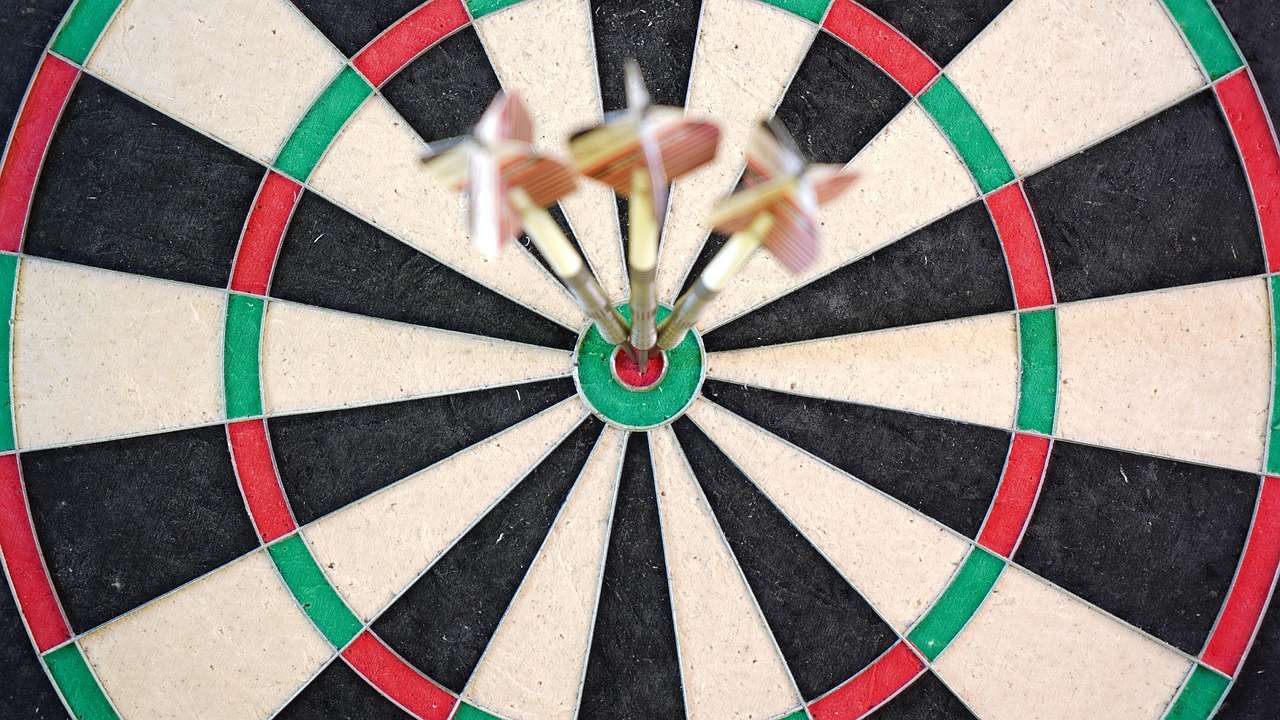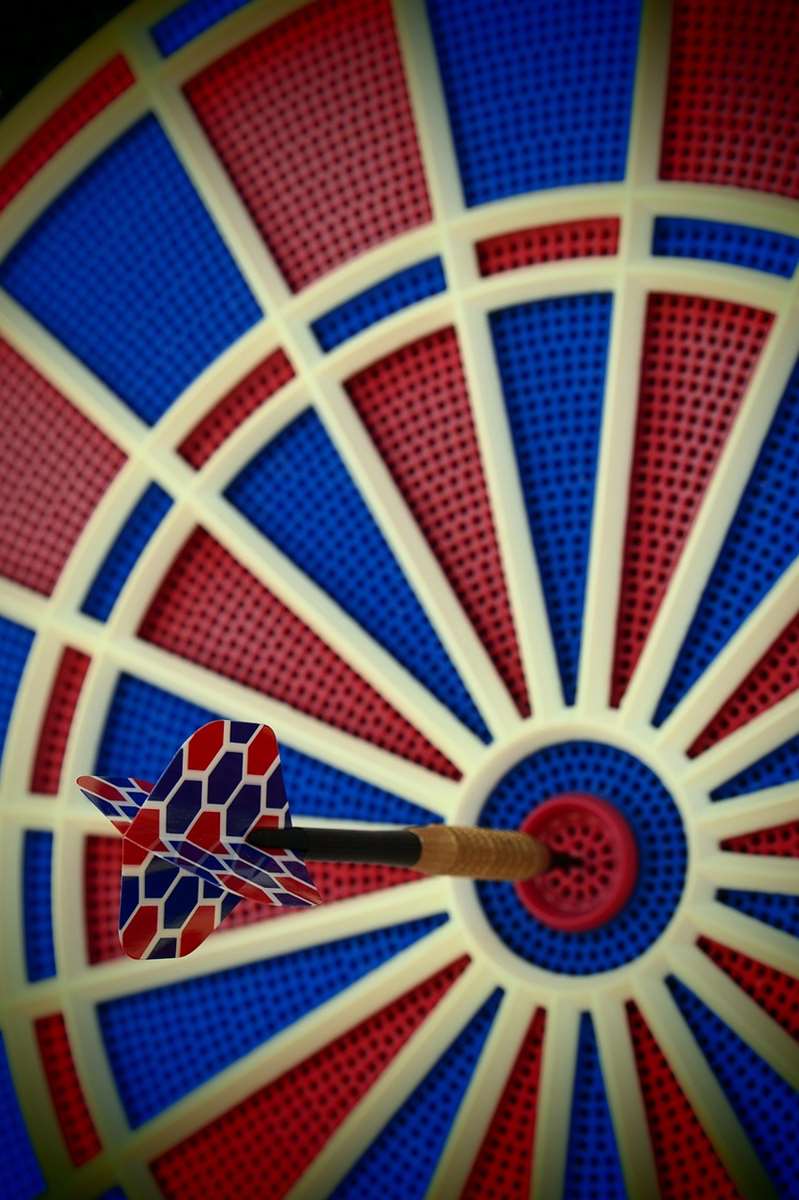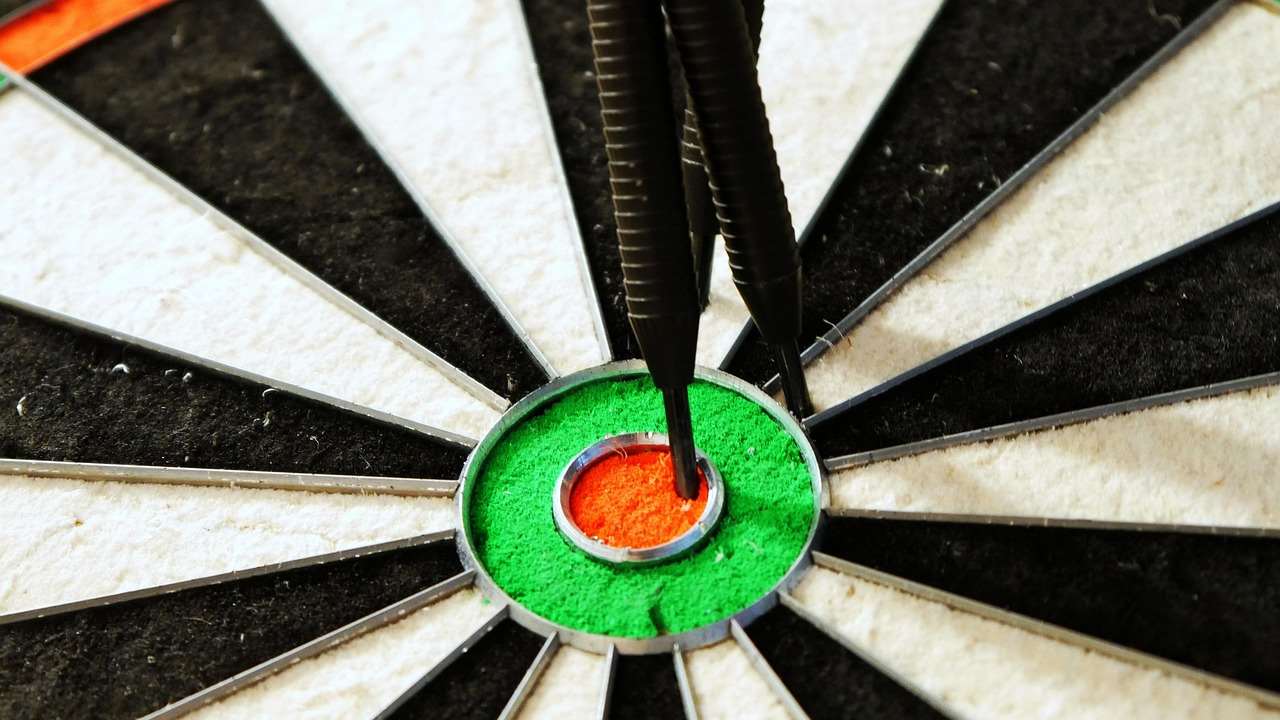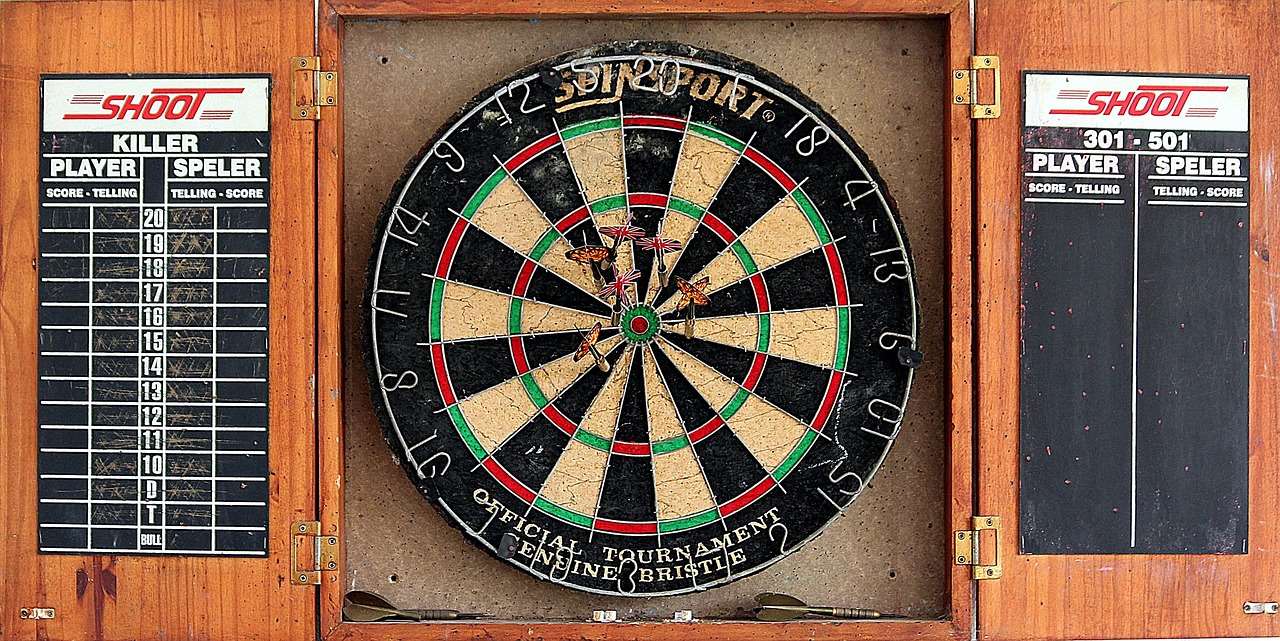Learning how to dart like a pro boils down to mastering your stance, grip, and throwing motion through consistent practice and a deep understanding of the game’s nuances. This article will guide you through every step, from choosing the right equipment to perfecting your mental game, helping you elevate your dart skills to a professional level.
⚠️ Still Using Pen & Paper (or a Chalkboard)?! ⚠️
Step into the future! The Dart Counter App handles all the scoring, suggests checkouts, and tracks your stats automatically. It's easier than you think!
Try the Smart Dart Counter App FREE!Ready for an upgrade? Click above!
Mastering the Fundamentals: The Foundation of a Pro Darter
Before you can consistently hit those trebles and perfect your checkouts, you need a solid foundation. This means focusing on the core elements of your darting technique, including your stance, grip, and throw. Neglecting these basics is a common mistake, and correcting them can dramatically improve your accuracy and consistency.
Finding Your Optimal Stance
Your stance is your anchor, providing stability and balance during your throw. There are three primary stances to consider:
- The Front-On Stance: Facing the board directly, this stance offers maximum stability but can restrict upper body rotation.
- The Side-On Stance: Standing perpendicular to the board, this stance allows for a more fluid throwing motion but may require more practice to master.
- The Angled Stance: A hybrid of the two, this stance provides a balance between stability and freedom of movement.
Experiment with each stance to determine which feels most comfortable and allows you to maintain balance throughout your throw. Once you’ve chosen your stance, ensure your weight is evenly distributed and your feet are firmly planted. A slight lean forward can help maintain balance, but avoid leaning too far, as this can disrupt your throw. You might even want to consider boulter v dart match strategies to see if anything learned can apply to standard dart playing.
The Perfect Grip: Achieving Control and Consistency
Your grip is your connection to the dart, dictating how much control you have over its flight. There’s no single “perfect” grip; it’s a matter of personal preference. However, some general principles apply:
- Consistency is Key: Once you find a grip that feels comfortable, stick with it. Avoid changing your grip mid-game, as this will disrupt your muscle memory.
- Avoid Over-Gripping: Holding the dart too tightly can create tension in your arm and wrist, leading to erratic throws. A relaxed grip allows for a smoother release.
- Experiment with Different Points of Contact: Try gripping the dart with two, three, or four fingers. See what feels most natural and gives you the best control.
Consider the type of darts you are using as well. For example, those looking for long barrel darts for sale should be aware that their grip may need to be different than someone using a shorter barrel.
Developing a Smooth and Repeatable Throw
Your throw is the culmination of your stance and grip, transforming potential energy into kinetic energy. A smooth, repeatable throw is essential for accuracy and consistency. Here’s how to develop one:
- The Backswing: Draw the dart back smoothly, keeping your elbow high and your wrist locked. Avoid excessive backswing, as this can lead to inconsistency.
- The Forward Motion: Bring the dart forward in a straight line, extending your arm fully. Release the dart just before your arm reaches full extension.
- The Follow-Through: Continue your throwing motion after releasing the dart, pointing your fingers towards the target. This ensures a complete and fluid throw.

Practice your throw regularly, focusing on consistency and smoothness. Record yourself throwing and analyze your technique. Identify any areas for improvement and make adjustments accordingly. Remember to check Electronic dart score counter, to assist in practice and accuracy.
Choosing the Right Equipment: Setting Yourself Up for Success
Having the right equipment can significantly impact your performance. This includes your darts, dartboard, and accessories. Selecting the right gear can contribute significantly to learning how to dart like a pro.
Selecting the Perfect Darts: Weight, Material, and Grip
Darts come in a variety of weights, materials, and grip styles. The best darts for you will depend on your personal preferences and throwing style. Here are some factors to consider:
- Weight: Darts typically range in weight from 18 to 30 grams. Lighter darts are generally easier to control, while heavier darts tend to be more stable in flight.
- Material: Darts are typically made from brass, nickel-silver, or tungsten. Tungsten darts are the most expensive but offer the best density, allowing for a slimmer barrel and a better grip.
- Grip: Darts come with a variety of grip styles, including knurled, ringed, and smooth. Experiment with different grip styles to find one that provides optimal control and comfort.
Choosing the Right Dartboard: Sisal Fiber vs. Electronic
Dartboards are typically made from sisal fiber or plastic. Sisal fiber dartboards are the traditional choice and offer superior durability and self-healing properties. Electronic dartboards are a more modern option and feature automatic scoring and various game modes.
Consider a bristle dartboard, which is made of tightly packed sisal fibers. These boards offer excellent durability and allow the darts to stick easily. A quality dartboard is essential for consistent scoring and long-term enjoyment of the game. Ensure you also understand darts killers scoring, to maximize your enjoyment.
Essential Dart Accessories: Flights, Shafts, and More
In addition to your darts and dartboard, there are several essential accessories that can enhance your darting experience:
- Flights: Flights are the wings of your darts, providing stability and lift. They come in various shapes and sizes, each affecting the dart’s flight characteristics.
- Shafts: Shafts connect the flight to the barrel and come in various lengths and materials. Shorter shafts offer more stability, while longer shafts provide more lift.
- Dart Mat: A dart mat protects your floor from stray darts and provides a designated throwing area.
- Dart Case: A dart case keeps your darts and accessories organized and protected.

Think about investing in a complete darts accessories set to have everything you need to maintain and optimize your equipment. Regular maintenance, such as replacing worn flights and shafts, is crucial for consistent performance.
The Mental Game: Sharpening Your Focus and Maintaining Composure
Darting is not just a physical skill; it’s also a mental game. Developing a strong mental game is crucial for maintaining focus, managing pressure, and performing consistently under pressure. This is a key aspect of learning how to dart like a pro.
Developing Pre-Throw Routines for Focus
A pre-throw routine is a sequence of actions you perform before each throw to help you focus and prepare mentally. This can include:
- Visualizing the Target: Close your eyes and visualize the dart hitting the target.
- Deep Breathing: Take a few deep breaths to calm your nerves and focus your mind.
- Positive Self-Talk: Repeat positive affirmations to boost your confidence.
Stick to your pre-throw routine consistently, even when you’re feeling pressured or distracted. This will help you maintain focus and perform at your best. Knowing darts how to score 180, can help with planning your throws.
Managing Pressure and Avoiding Tilt
Tilt is a state of mental frustration and anger that can negatively impact your performance. Here’s how to manage pressure and avoid tilt:
- Acknowledge Your Emotions: Don’t try to suppress your emotions. Acknowledge them and allow yourself to feel them.
- Take a Break: If you’re feeling overwhelmed, take a break from the game to clear your head.
- Focus on the Process, Not the Outcome: Concentrate on executing your throw correctly, rather than dwelling on the results.
The Power of Visualization and Positive Self-Talk
Visualization and positive self-talk are powerful tools for improving your mental game. Use them to build confidence, manage anxiety, and visualize success. Regularly visualize yourself throwing perfect darts and achieving your goals. Replace negative thoughts with positive affirmations, such as “I am a confident darter” or “I can hit this target.”

Consider incorporating mindfulness exercises into your daily routine to improve your focus and concentration. Even just a few minutes of meditation each day can make a significant difference in your mental game. Be sure to regularly keep abreast of news from groups like ab darts league.
Advanced Techniques: Taking Your Game to the Next Level
Once you’ve mastered the fundamentals and developed a strong mental game, you can start exploring advanced techniques to further improve your skills.
Checkout Strategies: Mastering the Art of Finishing
Checkouts are the final shots you need to win a leg or a match. Mastering checkout strategies is crucial for maximizing your scoring potential and closing out games. A few key strategies include:
- Planning Your Checkouts: Plan your checkouts in advance, considering your remaining score and the available doubles and trebles.
- Prioritizing High-Value Checkouts: Aim for high-value checkouts whenever possible, such as the bullseye (50) or double 20 (40).
- Practicing Common Checkouts: Practice common checkouts, such as 170, 167, and 164, until you can hit them consistently.
Understanding Dart Trajectory and Flight Characteristics
Understanding how your darts fly through the air can help you make adjustments to your technique and equipment to improve your accuracy. Consider things such as:
- The Angle of Attack: The angle at which your dart enters the board can affect its stability and accuracy.
- Dart Flight Shape and Size: Different flight shapes and sizes affect the dart’s lift and stability. Experiment with different flights to find what works best for your throwing style.
- Wind Conditions: Wind can affect the dart’s trajectory, especially when playing outdoors. Adjust your aim accordingly.
Advanced Practice Drills: Sharpening Your Skills
In addition to regular practice, incorporate advanced practice drills into your routine to challenge yourself and improve specific skills. These drills might include:
- Around the Clock: Hit each number on the board in sequence, starting with 1 and ending with 20.
- Shanghai: Hit the single, double, and treble of a specific number in one round.
- Bob’s 27: Start with 27 points and subtract the value of each dart you hit. The goal is to reach zero without going bust.

Always track your progress during practice sessions. This data can help you identify areas where you need to improve and monitor your overall development. And remember to consult a free darts checkout chart to ensure your technique is up-to-par.
Continuous Improvement: The Path to Professional Darting
Learning how to dart like a pro is not a destination; it’s a journey of continuous improvement. Here are some tips for staying motivated and continuing to develop your skills.
Seeking Feedback and Analyzing Your Performance
Seek feedback from other dart players, coaches, or even video recordings of your own games. Analyze your performance objectively and identify areas for improvement. Don’t be afraid to experiment with new techniques or equipment to see what works best for you.
Staying Motivated and Setting Realistic Goals
Set realistic goals for yourself and track your progress towards achieving them. Celebrate your successes, no matter how small, and learn from your failures. Remember why you started playing darts in the first place and keep that passion alive. Consider setting a goal for dart double decimal places and tracking your progress.
The Importance of Regular Practice and Competition
Regular practice is essential for maintaining your skills and developing new ones. Aim to practice at least a few times per week, even if it’s just for a short period of time. Compete in local tournaments or leagues to challenge yourself and gain experience playing under pressure.

Consider joining a darts club or league to connect with other players and learn from their experiences. Watching professional darts players and studying their techniques can also provide valuable insights and inspiration. Keep an eye out for information regarding jason watt darts and similar professional events.
Conclusion
Mastering darts and learning how to dart like a pro requires dedication, practice, and a willingness to learn and adapt. By focusing on the fundamentals, choosing the right equipment, developing a strong mental game, and continuously seeking improvement, you can elevate your darting skills to new heights. Remember to stay patient, persistent, and passionate about the game. Now, grab your darts, step up to the oche, and start practicing! Good luck, and may your darts fly true.
Hi, I’m Dieter, and I created Dartcounter (Dartcounterapp.com). My motivation wasn’t being a darts expert – quite the opposite! When I first started playing, I loved the game but found keeping accurate scores and tracking stats difficult and distracting.
I figured I couldn’t be the only one struggling with this. So, I decided to build a solution: an easy-to-use application that everyone, no matter their experience level, could use to manage scoring effortlessly.
My goal for Dartcounter was simple: let the app handle the numbers – the scoring, the averages, the stats, even checkout suggestions – so players could focus purely on their throw and enjoying the game. It began as a way to solve my own beginner’s problem, and I’m thrilled it has grown into a helpful tool for the wider darts community.